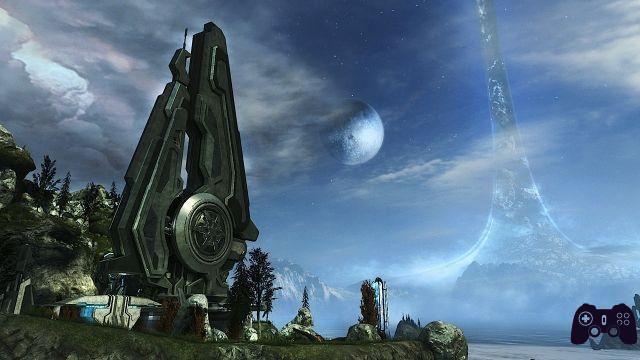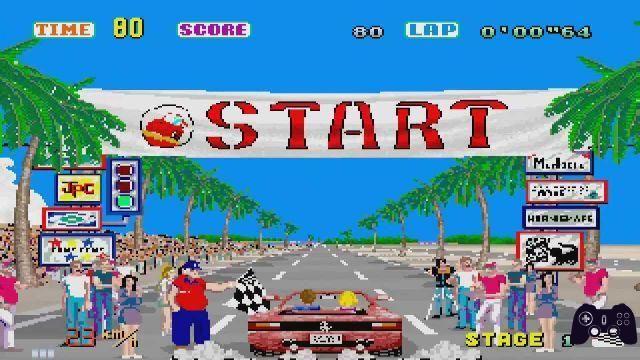
If I were to place Halo in the birth of modern FPS, I would propose a picture like this:
Thesis: Doom
Antithesis: Half-Life
Summary: Halo
Below I will analyze the synthesis - Halo: Combat Evolved - cornerstone of one of the most lucrative and influential franchises in the history of first person shooters and, more generally, of the medium.
A chaotic start
1997. We are in Chicago, Illinois. Bungie is a small company with just over 15 employees. Returning from the lukewarm success of very innovative games such as Marathon, the idea of produce a sci-fi themed RTS what privileges exploration of the environment. But when programming the developers understand that, for increase the immersion factor, it would have been interesting to also give the player the opportunity to observe the action from a soldier's point of view, or even allow him to drive vehicles directly.
Soon the Bungie guys realize that all this dynamism is hardly integrated to a strategy title, and so was the game evolves into a third person shooter. On June 21, 1999, the release of Halo for Mac and Windows is announced.

E3 2000
The definitive name "Halo"Was decided shortly before the presentation at E3 in 2000 and insisted on adding "Combat Evolved" because it was feared that "Halo" would just deviate from the military nature of the title to evoke "something religious or a women's shampoo". In retrospect I would say that the choice was very good: Halo is a short name, very evocative and above all with an unmistakable sound. By the time of E3, the game has made a good reputation among the insiders. And Microsoft, determined to launch Xbox with one killer app rivaling Sony, buys Bungie and gives them an exorbitant sum to polish the game and bring it to the console as FPS.
On November 15, 2001, the world meets Halo: a series that will sell 65 million copies.
But what made it the game that indissolubly shaped the history of the medium? What I propose below is an analysis of the elements that Halo has introduced or in any case improved, so as to make them canonical in the FPS genre.

While the Covenants were holding us captive, I heard the guards talk about the world made in a ring. They call it ... Halo, the halo.
The power of analogs

To learn more:
Halo 5: Guardians
If today the quality of console and PC games has more or less reached a level playing field, when Halo came out on Xbox the situation was very different. PC ports were often disappointing, not just for graphical downgrades, but above all for the inability to trace the simplicity of the visual and movement movements given by the mouse + keyboard combo. An early pioneer was Goldeneye 007 for the Nintendo 64, but there was still a long way to go. Sony proposed a joystick with two analogs, but was unable to offer games that knew how to exploit them properly for a smooth first-person view like on PC.
Halo comes and changes everything: not only does it create an experience that still struggles to age, but it will shape all the FPS after him. The Bungie guys figured out that for replicating the smoothness of the mouse with the analogs of the Xbox controller required a series of small adjustments, designed to make fighting against the Covenant hordes more liveable. Some examples:
- Acceleration: rotating the analog camera will move faster to slow down when aiming at an enemy
- Softlock combined with large hitboxes: Even if you're not really aiming at an enemy, the bullets will take a small bend to hit it and help us annihilate it.
Just by moving Master Chief's head on Autumn, players realized they had a game that looked to the future in their hands.

Only two weapons
Speaking of ours Spartan of trust, one of the most demanding challenges facing i Game Designer is to create eternal characters, figures that remain firmly iconic, as if they did not age. Master Chief is one of them: his green armor and his visor are inscribed in the history of the medium maintaining a characteristic charm, symbol of the whole Halo saga. But already at the time our super soldier differed from his colleagues - think of Serious Sam or Gordon Freeman - for a fact that, in its simplicity, enormously influences the gameplay: Master Chief can only carry two weapons.
Problem solving?
What today for normality, for the time was a real one revolution: not only did the player have to strive to defeat hordes and hordes of enemies with only two weapons, but he also had to use all his wit to adapt to every situation. In fact, the game offers the player several situations problem-solving, in which, say, the "pick up the sniper rifle" take the player to think about the situation in which this will come in handy, the ammunition at its disposal and above all which secondary weapon to pair it with, and how to act if this is not there.
Advanced AI
The team then made sure to shape theEnemy AI with very advanced criteria for the time: in addition to lurking around corners and using the means, if you killed the Elite foreman you would witness the disorderly escape of all his Grunts subordinates. From this point of view, Bungie has seen us along: the player can also collect the weapons of the enemies and create his own very personal gaming experience, addressing every situation as he sees fit.
Even though it's the norm today, it's with Halo that the “only two weapons” factor will become one of the most important canons of the FPS genre.
The self-healing shield
One thing that the Contemporary FPS they seem to have forgotten is the "life recovery". Many video games suffer from the so-called "smarmellato screen syndrome ", so after a certain number of shots the screen fills with blood and the movements slow down, making the protagonist a sort of Rambo who only has to wait for the return of the colors on the screen to begin yet another assault. All of course without a life bar.

To learn more:
Halo: The Master Chief Collection
Halo at the time offered a compromise very effective between tradition and modernity: Master Chief has a life bar that can only be recharged with i medi-kit, however, given the large amount of enemies he will face, the developers have well thought of giving the Spartan an energy shield so as not to make each level a sort of "cure hunt"; and this has a decisive influence on the gameplay.
A diverse gameplay
The player, being protected by the shield, will be urged to adopt one more offensive style of play - unlike almost any other FPS, such as Half-Life where the opposite attitude prevails - and matches will gain a lot in terms of dynamism. Often then the player will find himself having very little energy and the shield becomes the determining factor between life and death: he will have to revise his style of play once again, opting this time for a more attitude defensive and calculating his every move so as not to die, praying that the shield recharges quickly.

Like few other games of the era, Halo puts the player in the position of do not always adopt the same attitude in the face of different situations, in search of an increasingly heterogeneous approach. Not to mention that it is right the shield that allows the player to venture without too many thoughts in the endless environments of the ring, and thus give even more follow-up to that explorability factor that was so dear to the Bungie boys.
The Covenant manage to give a hard time precisely by virtue of their diversity (Grunt, Elite etc. etc.), going to change player behavior depending on which e How many enemies will be faced. In this sense, Halo very much incorporates the distinctions of demons and aliens typical of Doom and Half-Life.
The ring
Starting from very solid foundations, the game inserts the gameplay in levels that are very varied in size and characteristics. After the level on Autumn, specially made up of corridors and bottlenecks for taking familiarity with commands, the player is catapulted up Halo. The game thus opens up in all respects: huge areas, dozens of enemies, buildings, undergrounds and above all the means. From the very first level we are encouraged to take our beloved Warthog e wander through the huge play spaces, whose dimensions bring the player closer to an almost freeroaming experience, and thus not betraying the exploratory component already inserted in the most embryonic phases of the game. Not to mention the beauty of the moment we see the ring for the first time.

Not all roses and flowers
Unfortunately, and probably for the short time, Bungie failed to give the best in level design: next to the sequences outside, which are in themselves very enjoyable, we find entire sections indoors - especially in the Assault on the Control Room and The Library missions - which are nothing more than a copy and incolla of the usual 3 rooms and 2 corridors. The worst part is that of the snowy level, where the activation of the 3 generators takes place in a frightening monotony of dark rooms.
 Halo: The Master Chief Collection
Halo: The Master Chief CollectionOn amazon: 69,99 € buy
The level with the Flood manages to be already less exhausting precisely by virtue of the parasites: the game - which suddenly fills up with atmospheres à la Alien - puts the player in front of an unknown threat, which comes in the form of godzilliards of enemiesi, generating the tension and diverting the player's attention away from copy-pasting environments for a combat in which every bullet is necessary in order not to die.

The ear also wants its share
And Halo boasts of one immortal soundtrack - not surprisingly renowned among the best OSTs - which succeeds in something not exactly obvious: blend the military context with Gregorian chants, echoes, tribal drums and strings.
Composer Martin O'Donnell's idea was to succeed bring out from the soundtrack the epic, mysterious and ancient character of the ring on which we are catapulted.

To learn more:
Halo: Reach
But the glory of the sound industry doesn't come down to this: all the sounds involving Master Chief and weapons have one thing that few other games have: they are satisfying. The sounds of a melee attack or shotgun shot are big, fat, fill the air and satisfy the player's craving for Quality Casino ™ worthy of a FPS with countercoglioni.
A human hero
Also the cries of the Chief himself when he dies are on point: they are reduced to comic versacci that significantly reduce the incipient sense of ragequitting and play down the very death of the player, also going to lower the mighty Master Chief to the level of the player making him relatable, that is, allowing the player to recognize himself. Speaking of Avatar, I recommend this interesting article written by a colleague of mine.
And then tell me other games where every time you stay at least two minutes on the main menu just to hear that "ooOoOoooooooOooOoO"
Local and community multiplayer
The great thing about a game is talking about it with your friends, the great thing is playing it together. The Xbox Live service until 2002 will not be active, but this will not be an obstacle for the Bungie headline: 4 consoles, 4 televisions and 16 joysticks will be enough to create Legendary LAN parties and meeting people like you who loved the adventures of Master Chief, and thus build a solid community still in the age when the internet was pedaling and making noises. Even better, Halo with its simple and intuitive controls becomes accessible even to those of FPS they did not know or know nothing, thus becoming an extended leisure time, so to speak, to which everyone could try to play a game and laugh at their deaths.

A timeless classic
Halo was a memorable game, which made the history of the medium and the FPS genre and from which many games should take an example. And if a game with 18 years on its shoulders is still so relevant, then it should really be studied thoroughly. some of the mechanics that seem established today actually have their own history and how only with Halo they actually became so.
Creating a masterpiece of this size would have turned out to be a sword of Damocles for Bungie: skyrocketing hype, publicity, pressure from Microsoft, fans on fire. The sword will take the form of Halo 2, and will be released on November 9, 2004.






